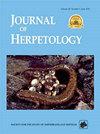A New Species of Pseudopaludicola Miranda-Ribeiro, 1926 (Anura, Leptodactylidae) from Tocantins State, Brazil
IF 0.8
4区 生物学
Q3 ZOOLOGY
引用次数: 0
Abstract
Abstract. The number of described species of Pseudopaludicola has increased at unprecedented rates over the past two decades. This increase was mainly driven by the sampling effort in regions historically neglected and the use of evidence from bioacoustic, genetic, and morphological datasets combined. Here, we describe a new species of Pseudopaludicola from a transitional zone between Amazonia and Cerrado in western Tocantins State as revealed through morphological, molecular, and bioacoustic analysis. Pseudopaludicola javae sp. nov. is distinguished from its congeners by its small size; knobbed terminal phalanges; smooth upper eyelids and heel; relatively short hind limbs; smooth, whitish, and subgular inflated vocal sac with few melanophores around the jaw; and advertisement call composed of an irregular series of multipulsed notes with 10–17 nonconcatenated pulses separated by intervals of 3–55 ms, emitted at a rate of 27–51 pulses/sec. The new species occurs in four Tocantins municipalities, all in the Araguaia–Tocantins interfluve. We also provide the first records of Pseudopaludicola jazmynmcdonaldae outside the type locality (Caseara Municipality, Tocantins State), extending its distribution nearly 245 km southward from Caseara. Pseudopaludicola javae sp. nov. is the second species of Pseudopaludicola described recently from western Tocantins. Resumo. O número de espécies de Pseudopaludicola descritas cresceu a taxas sem precedentes nas últimas duas décadas. Esse aumento foi impulsionado principalmente pelo esforço de amostragem em regiões historicamente negligenciadas e pelo uso de evidências bioacústicas, genéticas e morfológicas. Nós descrevemos uma nova espécie de Pseudopaludicola de uma zona de transição entre a Amazônia e o Cerrado no oeste do estado do Tocantins revelada através de análises morfológicas, moleculares e bioacústicas. Pseudopaludicola javae sp. nov. é diagnosticada de seus congêneres por seu pequeno tamanho, falanges terminais simples, pálpebras superiores e calcanhar lisos, membros posteriores relativamente curtos, saco vocal subgular, liso e esbranquiçado quando inflado com poucos melanóforos ao redor da mandíbula, e canto de anúncio composto por séries irregulares de notas com 10–17 pulsos não concatenados separados por intervalos de 3–55 ms, emitidos a uma taxa de 27–51 pulsos/s. A nova espécie ocorre em quatro municípios do Tocantins, todos no interflúvio Araguaia-Tocantins. Também fornecemos aqui os primeiros registros de P. jazmynmcdonaldae fora da localidade tipo (município de Caseara, estado do Tocantins), estendendo sua distribuição em cerca de 245 km em linha reta ao sul de Caseara. Pseudopaludicola javae sp. nov. é a segunda espécie de Pseudopaludicola descrita para o oeste do Tocantins nos últimos anos.来自巴西托坎廷斯州的 Pseudopaludicola Miranda-Ribeiro, 1926 新种(Anura, Leptodactylidae)
摘要:在过去二十年中,描述的伪尾柱虫物种数量以前所未有的速度增加。这一增长主要得益于在历史上被忽视地区的采样工作,以及对生物声学、遗传学和形态学数据集证据的综合利用。在这里,我们描述了通过形态学、分子学和生物声学分析揭示的托坎廷斯州西部亚马孙与塞拉多之间过渡地带的一个伪尾柱虫新物种。Pseudopaludicola javae sp.nov.与其同属物种的区别在于:体型小;末节趾骨有节;上眼睑和脚跟光滑;后肢相对较短;声囊光滑、带白色、近圆形,下颌周围有少量黑色素;广告呼叫由一系列不规则的多脉冲音符组成,其中有 10-17 个非闭合脉冲,间隔为 3-55 毫秒,以 27-51 脉冲/秒的速度发出。该新物种出现在托坎廷斯的四个市镇,均位于阿拉瓜亚-托坎廷斯交汇处。我们还首次在模式产地(托坎廷斯州卡萨拉市)之外记录到了伪尾柱虫,使其分布范围从卡萨拉向南扩展了近245公里。Pseudopaludicola javae sp.nov.是最近在托坎廷斯州西部描述的第二个Pseudopaludicola物种。总结。在过去二十年中,描述的伪尾柱虫物种数量以前所未有的速度增长。这一增长主要得益于在历来被忽视的地区开展的采样工作,以及生物声学、遗传学和形态学证据的使用。我们描述了通过形态学、分子学和生物声学分析发现的一个来自托坎廷斯州西部亚马逊和塞拉多之间过渡地带的伪尾柱虫新物种。Pseudopaludicola javae sp. nov.与同类的区别在于:体型较小、末端趾骨简单、上眼睑和脚跟光滑、后肢相对较短、声囊近囊状、充气时光滑且呈白色、下颌周围有少量黑色绒毛、鸣声由不规则的音符系列组成,其中有 10-17 个非闭合脉冲,间隔为 3-55 毫秒,以 27-51 脉冲/秒的速度发出。该新物种分布于托坎廷斯的四个城市,均位于阿拉瓜亚-托坎廷斯交汇处。我们还首次在模式产地(托坎廷斯州卡萨拉市)以外的地方记录到 P. jazmynmcdonaldae,将其分布范围扩大到卡萨拉以南约 245 公里处。Pseudopaludicola javae sp.nov.是近年来在托坎廷斯州西部描述的第二个Pseudopaludicola物种。
本文章由计算机程序翻译,如有差异,请以英文原文为准。
求助全文
约1分钟内获得全文
求助全文
来源期刊

Journal of Herpetology
生物-动物学
CiteScore
1.60
自引率
0.00%
发文量
45
审稿时长
6 months
期刊介绍:
The Journal of Herpetology accepts manuscripts on all aspects on the biology of amphibians and reptiles including their behavior, conservation, ecology, morphology, physiology, and systematics, as well as herpetological education. We encourage authors to submit manuscripts that are data-driven and rigorous tests of hypotheses, or provide thorough descriptions of novel taxa (living or fossil). Topics may address theoretical issues in a thoughtful, quantitative way. Reviews and policy papers that provide new insight on the herpetological sciences are also welcome, but they must be more than simple literature reviews. These papers must have a central focus that propose a new argument for understanding a concept or a new approach for answering a question or solving a problem. Focus sections that combine papers on related topics are normally determined by the Editors. Publication in the Long-Term Perspectives section is by invitation only. Papers on captive breeding, new techniques or sampling methods, anecdotal or isolated natural history observations, geographic range extensions, and essays should be submitted to our sister journal, Herpetological Review.
 求助内容:
求助内容: 应助结果提醒方式:
应助结果提醒方式:


